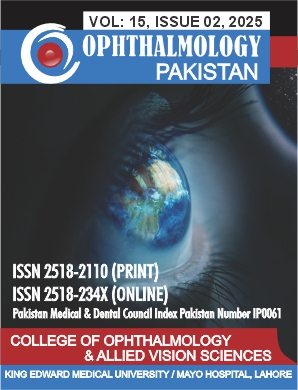Changes in Central Macular Thickness After Pan-Retinal Photocoagulation (PRP) in Proliferative Diabetic Retinopathy.
DOI:
https://doi.org/10.62276/OphthalmolPak.15.02.173Keywords:
Diabetes Mellitus (DM), Proliferative diabetic retinopathy (PDR), Pan-retinal photocoagulation (PRP), Optical Coherence Tomography (OCT), Centeral macular thickness (CMT)Abstract
Objective: This study evaluates the impact of pan-retinal photocoagulation (PRP) on central macular thickness (CMT) and visual acuity in patients with proliferative diabetic retinopathy (PDR).
Methods: This clinical case series followed 35 subjects with PDR who underwent PRP. Ethical approval was obtained from the research committee of Pak International Medical College and Hospital, Peshawar. Subjects underwent a baseline assessment, including visual acuity, refraction, slit-lamp microscopy, fundoscopy, and intraocular pressure measurement. Optical coherence tomography (OCT) was performed pre- and post-PRP to measure central macular thickness (CMT). A total of 1500–2000 mild to moderate burns were applied. Data analysis was conducted using SPSS Version 27, and paired T-tests was used to assess differences in pre- and post-treatment CMT values.
Results: The study participants' ages ranged from 32 to 65 years, with a mean age of 48.68. The pre-treatment CMT ranged from 231.51 to 244.49 µm (mean: 238.00 µm), while post-treatment CMT ranged from 239.42 to 245.85 µm (mean: 239.42 µm). The mean change in CMT was 1.42 µm. Significant increases in CMT were observed in both age groups (≤50 years, p=0.001; ≥50 years, p=0.002) and gender (males, p=0.002; females, p=0.001) after one month. The mean number of laser burns applied was 2013.
Conclusion: After one month, PRP significantly increased macular thickness in patients with PDR. The findings suggest that PRP is effective in managing proliferative diabetic retinopathy by altering retinal thickness, potentially impacting visual acuity outcomes.






